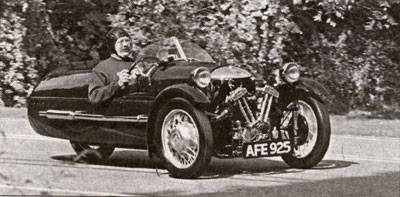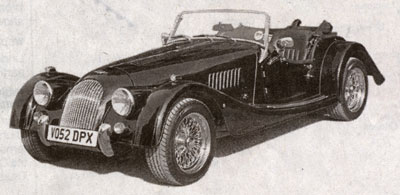Class News
Bill Fink '64 and the Mystique of the Eccentric Morgan
from The New York Times, April 5, 2004

The Morgan is the quintessential classic British sports car. Its 1935 design ― scoop "wing" fenders, bullet headlights, a leather-strapped bonnet and a wooden frame ― evokes those heady days when the sun never set on the empire. But for all the British pedigree of the Morgan Motor Company, it was the American market that kept it alive. When other icons of British motoring were dying off in the 1970's, a passionate community of Morgan owners and one very persistent dealer in the United States rallied to resuscitate the company's largest market.

Today, many in the Morgan community feel a bit betrayed. The car's classic body design managed to accommodate seven decades of automotive evolution. So why, they ask, does today's state-of-the-art engineering need to be wrapped in a faux-classic design, as it is in the company's all-new car, the Aero 8, which will make its East Coast debut this week at the New York International Auto Show?
"The Aero 8 breaks a lot of hearts," said Lorne M. Goldman, a retired Quebec judge who runs GoMoG, a Web site for Morgan owners. "You don't buy a car in 2004 that was designed in 1935 with-out having a love for a certain kind of look."

"It'll get you to church on time," Judge Goldman said with a laugh. "But let's face it: it was a 1968 engine, and 1968 engines have to obey 2004 emission laws."
The first emissions laws in the United States in the 1970's were half of a one-two death blow to legendary British roadster marques like Austin Healey, MG and Triumph. The other half was rampant labor strife in Britain.
Morgan never had much worker unrest at its plant in Malvern, England, where each car was handmade by highly skilled craftsmen rather than by assembly line workers. The company's then-managing director, Peter Morgan, nurtured a family atmosphere, refusing to expand or take on outside investors. Even today, Morgan typically produces no more than 800 cars a year.
But the emissions laws had an impact. Rover, the source of Morgan's engines, was unable to meet the standards. By 1971, Morgan was forced to exit the United States market, which, some years, had accounted for as much as 85 percent of its sales.
Rescue arrived two years later from Bill Fink, a former Morgan parts dealer in San Francisco. Mr. Fink began importing Plus 8's and modifying the Rover engines to run on propane, a fuel that was exempt from emission-control laws. Also, he modified the doors, frames and bumpers to meet evolving American safety requirements.
In a historical essay on the GoMoG Web site titled "Made in the U.S.A.," Judge Goldman wrote that Mr. Fink "heroically waded through the bureaucratic maze from 1973 to 1976 and was finally able to put a high-performance Morgan again on the American roads, meeting all U.S. standards."
Mr. Fink's modifications reopened Morgan's most lucrative market. For 15 years, the only Morgans sold in the United States were his propane-fueled Plus 8's. Until the Aero 8, the turbocharged propane-powered Plus 8's done by Mr. Fink were arguably the fastest, most powerful Morgans ever built for street use.
Just as Mr. Fink's innovations elevated him to deity status in Morgan circles, the Aero 8 has cast the company's current managing director, Charles Morgan ― son of Peter, who died in October ― as a villain.
It is not the Aero 8 itself than upsets Morgan owners, but the company's decision to suspend production of the "trads," the traditional-bodied Plus 8's. In Britain, the classic design will survive in the form of a new model, the Morgan Roadster, but that car's British-made Ford V-6 has not been approved for the United States.
For his part, Mr. Fink adamantly defends Charles Morgan, his new design and his stewardship of the company.
"It's not the Aero 8 that's the problem," Mr. Fink said. "It's the fact that people hate change, especially people as fond of tradition as Morgan owners."
Mr. Fink has much reason to love the Aero 8, too. His Isis Motors dealership has already taken deposits on 17 of the $110,000-plus cars. A few hours down the coast in Santa Monica, Dennis Glavis, owner of the Morgan West dealership, has also taken 17 orders for the car.
"No car company can stand stilt and survive," Mr. Glavis said. "Charles Morgan did not design this car for the traditional Morgan folks. He built It to expand the customer base. You can't blame them for not liking that, but the response is proving him right."

